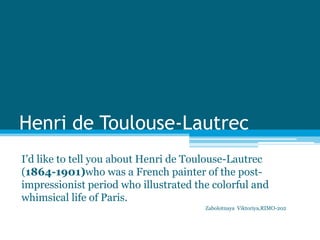
Henri de Toulouse-Lautrec Biography
- 1. Henri de Toulouse-Lautrec I’d like to tell you about Henri de Toulouse-Lautrec (1864-1901)who was a French painter of the post- impressionist period who illustrated the colorful and whimsical life of Paris. Zabolotnaya Viktoriya,RIMO-202
- 2. Biography of Henri de Toulouse- Lautrec Henri Marie Raymond de Toulouse-Lautrec- Monfa—simply known as Henri de Toulouse- Lautrec was born into an aristocratic family in the south of France in 1864. His father, Count Alphonse, was a notorious eccentric known for all kinds of unpredictable behavior: from washing his socks in the river (unheard of for an aristocrat!) to galloping off to a hunt wearing outlandish costumes, to simply disappearing for long stretches of time. The young Henri never became very close to him. Unknown at the time, Henri suffered from a genetic condition that prevented his bones from healing properly. Fatefully, at age twelve, he broke his left leg. And at age fourteen, he broke his right leg. Both legs ceased to grow, while the rest of his body continued to grow normally. At maturity, Lautrec was 4 1/2 feet tall. But his great misfortune was a sort of blessing in disguise, at least from our perspective. After his accidents he was no longer able to follow his father in the typically aristocratic pastimes of riding and hunting. Instead, he focused on sketching and painting.
- 3. His father Count Alphonse
- 4. • • In his late teens, Lautrec was honored to become a Art and alcohol student of the artist Fernand Cormon, whose studio was located on the hill above Paris, Montmartre. • Toulouse-Lautrec mostly moved in the social circles in Montmartre, the well-known Parisian haunt for bohemians, fellow artists, writers, philosophers, and other personalities. After studying under Bonnat, Toulouse-Lautrec transferred under the tutelage of Fernand Cormon in 1882. It was here where he struck friendships with some of his most enduring companions, such as Emile Bernard and Van Gogh. After his studies, he participated in an exhibit in 1887, and later on in Paris with Van Gogh and other friends. With the opening of the famous Moulin Rouge cabaret, Toulouse-Lautrec produced arguably his most famous and recognizable work in the form of posters for the club revue. Despite the perceived lowliness of such a job or endeavor, Toulouse-Lautrec persisted thanks to his aristocratic background that somehow imparted a sense of superiority and detachment from those negative perceptions. He therefore also became a valued guest of the cabare.
- 6. • Toulouse-Lautrec’s emotional troubles due to his physical handicap continued to hound him in adulthood, unfortunately, and he turned to alcohol to deal with the distress. He enjoyed beer, wine, and American-style mixed drinks and cocktails, which were just beginning to become popular at that time. A cocktail drink was even attributed or supposedly created by Toulouse-Lautrec, utilizing absinthe, the popular distilled alcohol and addictive substance during that time. • By 1893, Toulouse-Lautrec began suffering the consequences of his alcoholism, which led to his being entered into a sanatorium in 1899. Unfortunately, he passed away just shortly after in 1901 due to alcoholic complications and syphilis. His mother sought to promote his art even after his death, eventually establishing the Toulouse-Lautrec Museum, which today houses the world’s largest collection of works by the painter.
- 7. His grave
- 9. • Today we know Henri de Toulouse-Lautrec as the archetypical bohemian artist of the belle époque, the "beautiful era" in Paris in the last decade of the 19th Century. He helped usher in the new century, and died when the job was done. • Lautrec captured the spirit and emotion of the era in his posters and portraits. Although his handicap and his alcohol abuse kept him from enjoying some of life's pleasures, Lautrec clearly shared in the joie de vivre of the time.
- 10. Lautrec paintied en plain air in the manner of the Impressionists, and often posed sitters in the Montmartre garden of his neighbor. His favorite models was a prostitute nicknamed La Casque d'Or (Golden Helmet.Lautrec used peinture à l'essence, or oil thinned with turpentine, on cardboard, rendering visible his loose, sketchy brushwork. The transposition of this creature of the night to the bright light of day—her pallid complexion and artificial hair color clash with the naturalistic setting—signals Lautrec's fascination with sordid and dissolute subjects Lautrec eventually established himself as the premier poster artist of Paris and was often commissioned to advertise famous performers in his prints.
- 11. Jane Avril ,1892
- 12. Helen Vary,1889
- 14. Ball at the opera